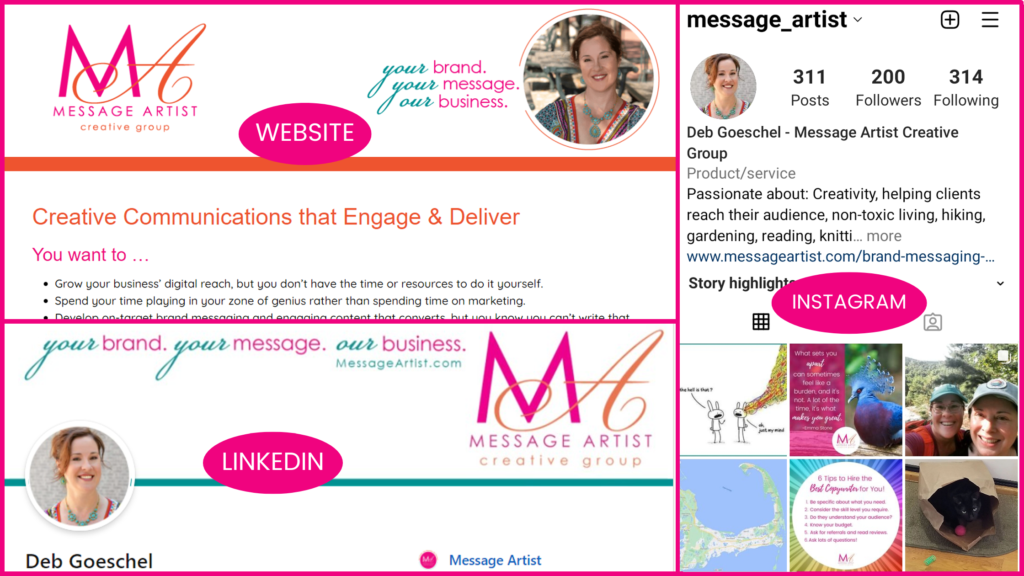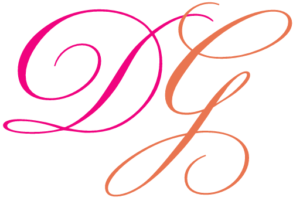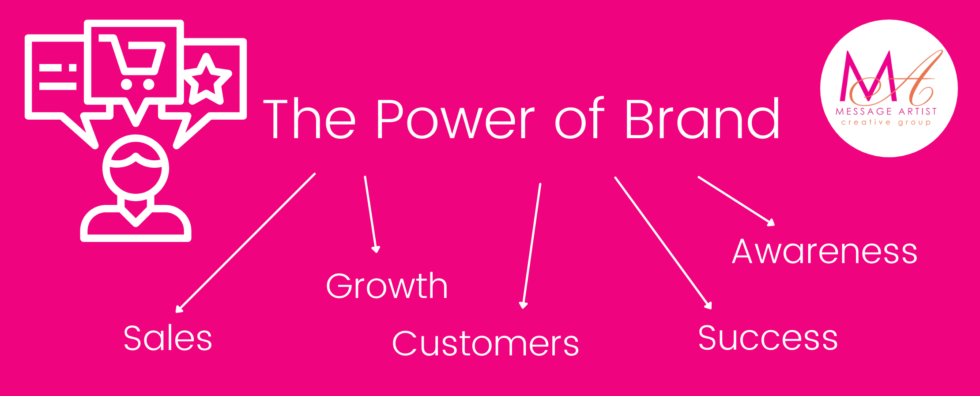These days there are so many platforms you can use to share your message, your story, your business. That means lot of opportunities to get your brand in front of people. However, the multitude of options may feel daunting. At Message Artist Creative Group, we help our clients look at the process of sharing their brand story in a way that is collaborative, creative, and relatively easy. We develop a strategy, create a plan, and then we commit and implement it … and make adjustments when and if necessary. This post shares some of the steps we take to effectively deliver brand consistency.
Consistency Makes Your Brand Recognizable
To help people get to know your brand and recognize it right away, consistency is key. Your message is the starting point for consistency, as it informs everything else. (For guidance on messaging, check out my blog post, The Foundation of Your Brand, or listen to my guest spot on The Marketing Essentials podcast where we talk about the imprortance of messaging in your marketing.)
Your written and visual content need to be consistent all the time, everywhere. This means the voice and tone of your copy and the look of your materials needs to be the same on your social media pages, your homepage, and your print materials. We often think of social media as informal and something like a donation request letter (or any kind of letter) as formal. But no matter what you do for outreach, formal or informal, you need to maintain brand consistency in voice and look so your brand is instantly recognizable to your current and potential clients and customers.

So, simply put, be consistent everywhere your brand shows up! In your …
- Brand message
- Copy content
- Voice/tone of content
- Visual Identity: logo(s), fonts, color palette
- Images & graphics
- Videos
- Annual reports, case studies, and any other print materials
- And more …
The list is long and it doesn’t even include a few social media specifics that I’ll mention later in the post. So … how can you keep track of everything?
Create a Brand Guide
To help ensure that you, and everyone who works for you, is consistent with your brand, it’s a good idea to have a brand guide. This sets the standard for your written and visual content. It can be referenced time and time again and also updated as changes occur. Much like a style guide lets staff know standards for punctuation and capitalization, a brand guide ensures consistency for specifics like the size, style, and color of fonts across platforms. A comprehensive brand guide will also include things like your mission, vision, unique value proposition (UVP), and your ideal customer profile.
Personality Check (For Your Brand)
While the brand guide is a methodical way to be consistent, a brand personality check is an intuitive way to be consistent. Both approaches are equally important to how you convey your brand. Just like people have different personalities, brands have different personalities. Some are more serious with a formal feel while others are casual with a friendly feel. Clients sense this feeling when they interact across your platforms. If your brand vibe is casual and friendly on social media, but formal on your website, your clients may be confused. (Learn more about message match with this blog post.) To avoid confusion, create content that aligns with how your brand feels and looks and monitor your platforms for vibe consistency. Be intentional about the look and feel of what you share.

Brand Interaction on Social Media
Social media is a valuable place to express your brand because there is so much opportunity for interaction. Clients can interact with your brand every time you post, which is why you should post on a regular basis.
Social media sites also offer additional ways to brand in the form of: handles, bios, and banners. Your banner for Twitter, Instagram, Facebook, and LinkedIn could vary slightly, but it needs to be instantly recognizable as your brand with colors, fonts, logos, graphics, image, and copy.
This is all making sense, right? I may sound like a broken record, but seriously, maintaining your brand across all platforms boils down to being consistent across all platforms.
One more thing to mention when it comes to social sites. If you’re not familiar with Google My Business (GMB) as an option for a social site, look into it. Yes, there’s a map listing, but it’s not just for brick and mortar businesses!. It’s the business profile you create that allows you to post and engage with clients just like you would on other social sites. AND it sets you up for better results when it comes to organic search. The top benefits of using a GMB listing are:
- Increase visibility
- Share key information with customers
- Share update posts, announcements, etc
- Interact quickly and efficiently with customers
- Increase traffic to website and sales
- Immediately visible reviews
GMB is a great option for drawing people in based on your location, reviews, and for leads to immediately see what you do/offer and positive reviews help them easily take action. With your branding strategy all set to go, you can convert these Google searchers to clients!
Need More Guidance on Branding?
Developing and maintaining a brand can be fun. Naturally, at Message Artist, we’re always helping clients with their brand. We LOVE it, but you may not. Or maybe you simply don’t have the time for it. Reach out and let’s chat.



0 Comments